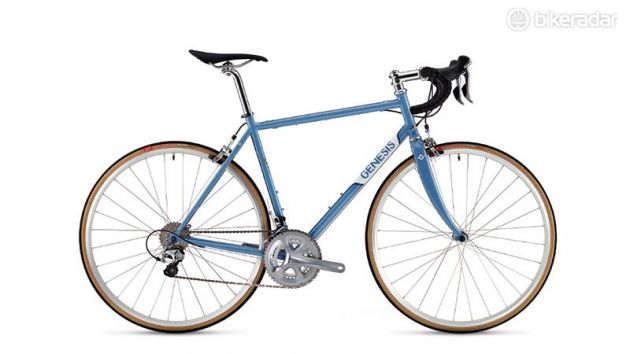
If you could distil the soul of British road cycling into a single bike, what do you think it would look like? We’ve a hunch it would be something like the Genesis Equilibrium 20.
The Equilibrium has been with us for a few years now, available in a huge range of different builds — cheap, expensive, disc, rim brake, titanium — the list goes on. The essential formula of a simple, practical, metal bike hasn’t changed radically, but this year’s Equilibrium 20 kicks the retro styling up a notch with a very classy paint job and some tidy silver components.
We particularly appreciate the colour-matched fork and the tan-wall Clément tyresare the icing on a deliciously old-school cake. Under the skin it’s a familiar story, with Reynolds mid-range 725 tubing offering reasonable weight to an elegant, understated frame. (725 is based on the ubiquitous 4130 chromoly, popular for its all-round qualities and relative affordability.)

Although the slightly sloped top-tube is arguably a modern touch, the Equilibrium doesn’t make any pretence of being remotely cutting edge, with cables fully on show, a threaded bottom bracket and a straight head-tube with external headset cups.
We’ve no complaints, although dropping the fork out reveals that the ‘semi-cartridge’ bearings in the headset are just bog standard ball-in-cage units — slightly underwhelming at this price.
We’re pleased to note that the Equilibrium’s rack and mudguard mounts are present, as are the clearances needed for the latter.
We don’t get sent many bikes built with the silver version of Shimano’s outstanding mid-level 105 groupset and we think that’s a shame because it looks very handsome, particularly on a bike as unapologetically old school as this one.
Genesis has gone all-in with the metallic theme; in addition to the shifting components and the cranks, the cockpit, headset, seatpost, rims, wheels and brakes are all as silver as they come. None of it is exotic fare, but it all looks the part and with one exception does a pretty decent job.

That exception is the brakes: the calipers are low-end Promax units and they’re the one aspect we’d look to upgrade — their finish is not great and they just don’t offer the reassuring stopping power of Shimano’s own offerings.
That’s the only real issue we encountered riding the Equilibrium. The 725 tubing affords the bike a pleasing solidity on the road and while it’s not ultra-compliant, it is smooth and engaging, as well as being lively in exactly the way you’d hope decent quality steel might be.
Modern steel isn’t stupidly heavy and the stiffness it offers when used intelligently can make for an exciting ride. The Equilibrium scores well here, with a willing persona that belies its unremarkable weight figure — it feels lighter than it is, and importantly, it’s fun. It feels at home zipping along leaf-strewn lanes and it’s sharper and more rewarding than you might assume.
We can’t help but like the Genesis. It’s a slightly underwhelming proposition on paper with a middling spec and not inconsiderable weight, but it manages to be likeable in the real world.
If you’re looking for a cheerful all-rounder that will age gracefully, buy one, stick mudguards on it, and get out and ride.
This article was originally published in Cycling Plus magazine, available on Apple Newsstand and Zinio.
[“Source-bikeradar”]





